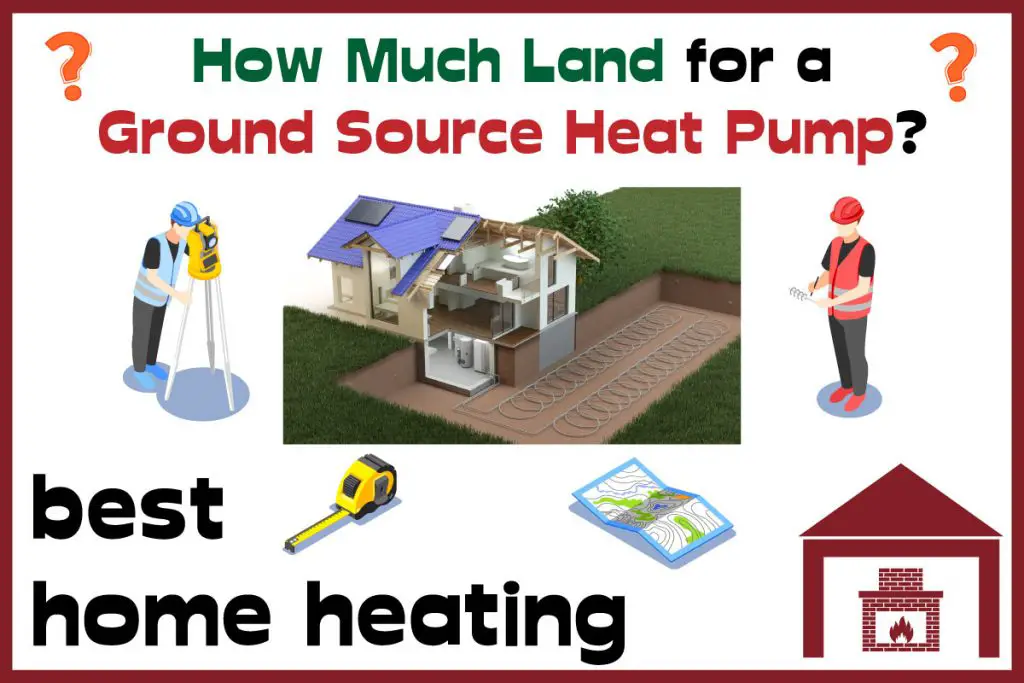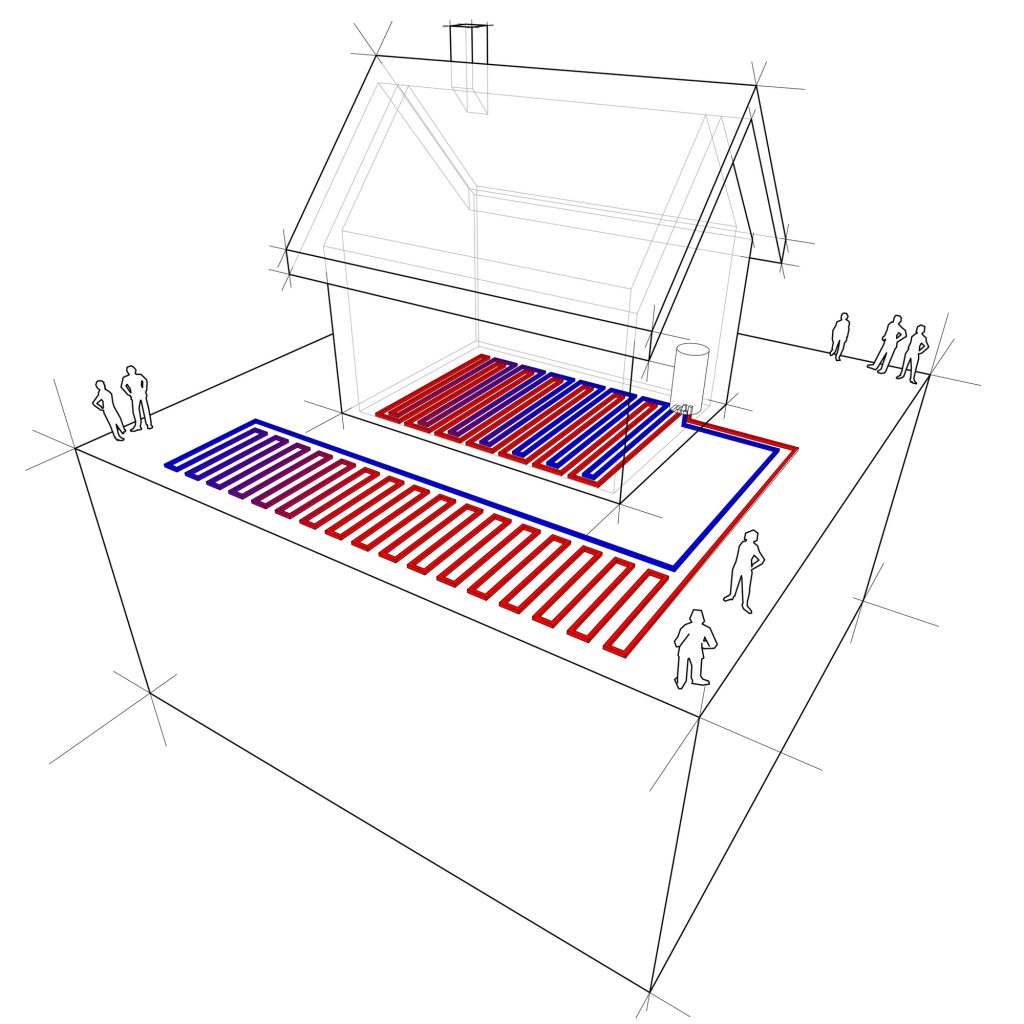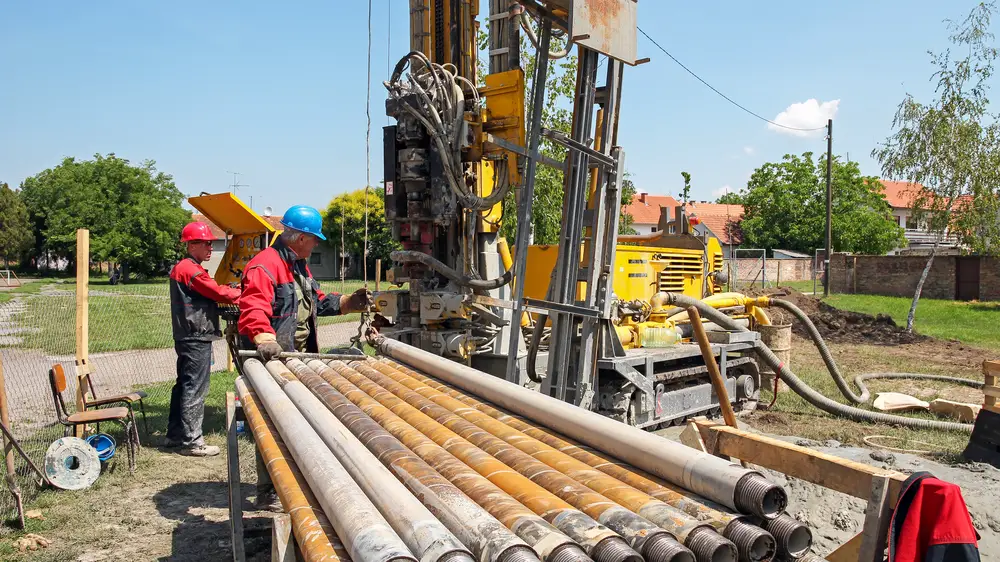Geothermal heat pumps are environment-friendly, durable, and require little energy to run. However, the installation of a geothermal system requires some land, and that is a concern for many homeowners. But exactly how much land does its ground loops array require??
On average, horizontal ground loops require a land space, 100meters long, 7 meters wide, and 1-2 meters deep, depending on the soil texture. Vertical ground loops would require a depth of 100m, with the hole being at least 20cm wide. Multiple vertical ground loops would require a spacing of 5-6m from the next borehole.
The ground source heat pump would need to be placed in a utility room, a garage, or a dedicated plant room. The area of the room should be 1×3 times larger than the size of the heat pump.
In this post, we are going to discuss everything you need to know about getting a geothermal heat pump installed. Read on to learn if this sophisticated heating and cooling technology is a good option for your home.

How does a geothermal heat pump work?
Just a couple of meters below the ground, there is a constant temperature of about 8-12° all year-round. A ground source heat pump takes advantage of this. The system consists of underground pipes that have an antifreeze liquid in them. The antifreeze mix absorbs warmth from the ground and then moves to a heat exchanger.
The heat exchanger transfers the ground heat to a refrigerant, which boils and turns into a gas. The gas then passes through a compressor, which raises the temperature of the gas. Finally, the hot gas reaches a condenser. This device circulates the heat through radiators or underfloor heating systems.
The underground pipes can be laid horizontally or vertically. Horizontal systems are more common, in part because of the reduced costs. But the installation of a horizontal system requires a considerable amount of land area. That is why a horizontal system is a good option only for a home with a large garden.
For homes that lack enough space, a vertical system can be an alternative. It can be installed in a small land area. In the next section, we will discuss the land requirements in detail.
How much land do you need for a horizontal array of ground loops?
For horizontal ground loops, trenches are shallow—usually, 1-2 meters deep and 100 meters long. The total land area required for the installation depends on your energy requirements. Here is a simple way to figure out how much land is needed for a horizontal array geothermal heat pump:
According to Thermal Earth–a Wales-based provider, the area needed is roughly 2.5 times the area of your house. For example, assuming that your house measures 2,500 square feet, here’s how you have to calculate it:
2,500sq ft x 2.5 = 6,250 square feet of land required.
That’s a pretty large chunk of land. If the soil is sandy, even more space will be needed. Again, a small excavator is used to dig the trenches. So, there must be enough room for the excavator to enter the site.
Some other factors also have to be taken into consideration. If there are water and sewage pipes, you have to get permission from the water supplier.

How much land do you need for Vertical array of ground loops?
For homes that do not have gardens or much space, there is an alternative: a vertical system, also known as a borehole system. The installation involves drilling vertical holes about 100 meters deep.
At this depth, the ground has a constant temperature of 10-12°C. Changing seasons has very little effect on vertical systems, and that’s part of the reason why these systems are often more efficient. Each borehole is 5-6 inches in diameter. If the system requires multiple boreholes, they are placed 5-6 meters apart.
The number of boreholes depends on the energy requirements of your home. As a rule of thumb, one borehole can produce 6kw of power, which may be enough for a small home with the most basic heating and cooling needs. Drilling a borehole takes approximately 2 days.
Before you dig vertical boreholes, it is important to check the type of ground, because sandy ground is not ideal for this system. Wet and rocky grounds provide the best results. A reliable provider of geothermal heat pumps can carry out a site survey.
It should be noted here that geothermal energy extraction and residential ground source heat pumps are not the same. Large power plants extract geothermal energy stored several miles underground. To extract heat, huge wells are drilled. And the energy is used almost exclusively for commercial purposes.
Residential ground source heat pumps, in contrast, harvests the heat which the ground receives from the sun. As we have stated, a horizontal loop system requires digging just 1-2 meters, and a vertical borehole system requires digging about 100 meters.
Check out this video from IMS Heat Pumps on Youtube showing you details about the process of installing both horizontal array and vertical borehole ground source heat pumps.
Does a larger ground loop lead to more heat generation?
The ground arrays are the most expensive component of a geothermal heating and cooling system. These arrays absorb heat from the ground. For the best results, the array system must be seized and installed correctly.
To determine the size of the ground loop, you have to consider three factors: the size of the heat pump, the type of soil, and the overall climate.
For borehole heat pumps, if the soil is composed of loose gravel, one meter of an active collector(ground pipes) provides around 24 watts. And if the soil is composed of saturated stone, the same array provides about 70 watts.
A larger array is needed for a larger heat pump. However, the other components of the system must be compatible with the length of the array.

What are the differences in initial cost and amount of building work between horizontal and vertical borehole GSHPs?
Installing horizontal arrays is usually cheaper than vertical boreholes, in part because the former does not require drilling equipment. The cost depends on a host of factors such as local geology, underground features such as the presence of sharp stones, the time required for excavating the trenches, and landscaping.
In general, one vertical borehole costs around £10,000. It is because of the initial equipment mobilization. For multiple boreholes, the cost per borehole will drop to around £6,000.
How large and how deep should commercial ground source heat pumps be?
Commercial ground source heat pumps can meet the heating and cooling demands of offices, council buildings, farms, schools, and universities. To balance high heat demands and aid energy efficiency, multiple heat pumps are connected, creating a cascaded system. While installing a large heat pump is a viable option, a cascaded system is more convenient.
There are a host of benefits of a cascaded ground source heat pump: meeting a high heat load, maximizing efficiency, adjusting to seasonal variations, reducing overheating, and adding redundancy. When there is a low demand for heat in the summertime, you can run one unit in isolation.
In general, each unit is dedicated to one purpose, such as space heating or water heating. This system also has a central ground array infrastructure, which is appropriately sized to meet the peak heating and cooling demands.
Conclusion and Summary
The size of a ground source heat pump depends on your heating and cooling needs. A typical horizontal system requires around 7,500 square feet of land. If your house needs 10kw of heating capacity, the system will most probably require 3 boreholes of 100 m deep.
Before you decide to invest in a ground source heat pump, learn as much as possible about the technology. If you have more specific questions, consider getting in touch with a reliable provider.
Check out all our other information on ground source heat pumps here:
- What Temperature do Ground Source Heat Pumps Produce?
- Do Ground Source Heat Pumps work in Winter?
- Are Ground Source Heat Pumps good for the environment?
- Can Ground Source Heat Pumps work with Radiators?
- Can you combine Ground Source Heat Pumps with Underfloor Heating?
- How much land do you need for a Ground Source Heat Pump?
- Can Heat Pumps Cool?
- How long do heat pumps last? Ground Source Heat Pump Lifespans
- Are ground source heat pumps safe?
